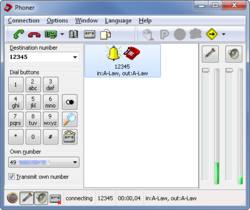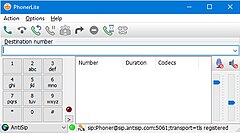
Integrated Services Digital Network (ISDN) is a set of communication standards for simultaneous digital transmission of voice, video, data, and other network services over the digitalised circuits of the public switched telephone network. Work on the standard began in 1980 at Bell Labs and was formally standardized in 1988 in the CCITT "Red Book". By the time the standard was released, newer networking systems with much greater speeds were available, and ISDN saw relatively little uptake in the wider market. One estimate suggests ISDN use peaked at a worldwide total of 25 million subscribers at a time when 1.3 billion analog lines were in use. ISDN has largely been replaced with digital subscriber line (DSL) systems of much higher performance.
Speech coding is an application of data compression to digital audio signals containing speech. Speech coding uses speech-specific parameter estimation using audio signal processing techniques to model the speech signal, combined with generic data compression algorithms to represent the resulting modeled parameters in a compact bitstream.
Digital subscriber line is a family of technologies that are used to transmit digital data over telephone lines. In telecommunications marketing, the term DSL is widely understood to mean asymmetric digital subscriber line (ADSL), the most commonly installed DSL technology, for Internet access.
Telephony is the field of technology involving the development, application, and deployment of telecommunication services for the purpose of electronic transmission of voice, fax, or data, between distant parties. The history of telephony is intimately linked to the invention and development of the telephone.
Speex is an audio compression codec specifically tuned for the reproduction of human speech and also a free software speech codec that may be used on VoIP applications and podcasts. It is based on the CELP speech coding algorithm. Its creators claim Speex to be free of any patent restrictions and it is licensed under the revised (3-clause) BSD license. It may be used with the Ogg container format or directly transmitted over UDP/RTP. It may also be used with the FLV container format.
Voice over Internet Protocol (VoIP), also called IP telephony, is a method and group of technologies for voice calls, the delivery of voice communication sessions over Internet Protocol (IP) networks, such as the Internet.

G.711 is a narrowband audio codec originally designed for use in telephony that provides toll-quality audio at 64 kbit/s. It is an ITU-T standard (Recommendation) for audio encoding, titled Pulse code modulation (PCM) of voice frequencies released for use in 1972.

G.729 is a royalty-free narrow-band vocoder-based audio data compression algorithm using a frame length of 10 milliseconds. It is officially described as Coding of speech at 8 kbit/s using code-excited linear prediction speech coding (CS-ACELP), and was introduced in 1996. The wide-band extension of G.729 is called G.729.1, which equals G.729 Annex J.

G.722 is an ITU-T standard 7 kHz wideband audio codec operating at 48, 56 and 64 kbit/s. It was approved by ITU-T in November 1988. Technology of the codec is based on sub-band ADPCM (SB-ADPCM). The corresponding narrow-band codec based on the same technology is G.726.

G.726 is an ITU-T ADPCM speech codec standard covering the transmission of voice at rates of 16, 24, 32, and 40 kbit/s. It was introduced to supersede both G.721, which covered ADPCM at 32 kbit/s, and G.723, which described ADPCM for 24 and 40 kbit/s. G.726 also introduced a new 16 kbit/s rate. The four bit rates associated with G.726 are often referred to by the bit size of a sample, which are 2, 3, 4, and 5-bits respectively. The corresponding wide-band codec based on the same technology is G.722.

A VoIP phone or IP phone uses voice over IP technologies for placing and transmitting telephone calls over an IP network, such as the Internet. This is in contrast to a standard phone which uses the traditional public switched telephone network (PSTN).
Gizmo5 was a voice over IP communications network and a proprietary freeware soft phone for that network. On November 12, 2009, Google announced that it had acquired Gizmo5. On March 4, 2011, Google announced that the service would be discontinued as of April 3, 2011.
Internet Low Bitrate Codec (iLBC) is a royalty-free narrowband speech audio coding format and an open-source reference implementation (codec), developed by Global IP Solutions (GIPS) formerly Global IP Sound. It was formerly freeware with limitations on commercial use, but since 2011 it is available under a free software/open source license as a part of the open source WebRTC project. It is suitable for VoIP applications, streaming audio, archival and messaging. The algorithm is a version of block-independent linear predictive coding, with the choice of data frame lengths of 20 and 30 milliseconds. The encoded blocks have to be encapsulated in a suitable protocol for transport, usually the Real-time Transport Protocol (RTP).
internet Speech Audio Codec (iSAC) is a wideband speech codec, developed by Global IP Solutions (GIPS). It is suitable for VoIP applications and streaming audio. The encoded blocks have to be encapsulated in a suitable protocol for transport, e.g. RTP.

Twinkle is a free and open-source application for voice communications over Voice over IP (VoIP) protocol.

Linphone is a free voice over IP softphone, SIP client and service. It may be used for audio and video direct calls and calls through any VoIP softswitch or IP-PBX. Linphone also provides the possibility to exchange instant messages. It has a simple multilanguage interface based on Qt for GUI and can also be run as a console-mode application on Linux.
Siren is a family of patented, transform-based, wideband audio coding formats and their audio codec implementations developed and licensed by PictureTel Corporation. There are three Siren codecs: Siren 7, Siren 14 and Siren 22.
Wideband audio, also known as wideband voice or HD voice, is high definition voice quality for telephony audio, contrasted with standard digital telephony "toll quality". It extends the frequency range of audio signals transmitted over telephone lines, resulting in higher quality speech. The range of the human voice extends from 100 Hz to 17 kHz but traditional, voiceband or narrowband telephone calls limit audio frequencies to the range of 300 Hz to 3.4 kHz. Wideband audio relaxes the bandwidth limitation and transmits in the audio frequency range of 50 Hz to 7 kHz. In addition, some wideband codecs may use a higher audio bit depth of 16 bits to encode samples, also resulting in much better voice quality.

The Common ISDN Application Programming Interface is an ISDN-conformant standardized software interface. With the help of CAPI, computer software intended for the use with ISDN can be provided, without knowledge of the deployed, proprietary ISDN card.
Pulse-code modulation (PCM) is a method used to digitally represent sampled analog signals. It is the standard form of digital audio in computers, compact discs, digital telephony and other digital audio applications. In a PCM stream, the amplitude of the analog signal is sampled at uniform intervals, and each sample is quantized to the nearest value within a range of digital steps.







